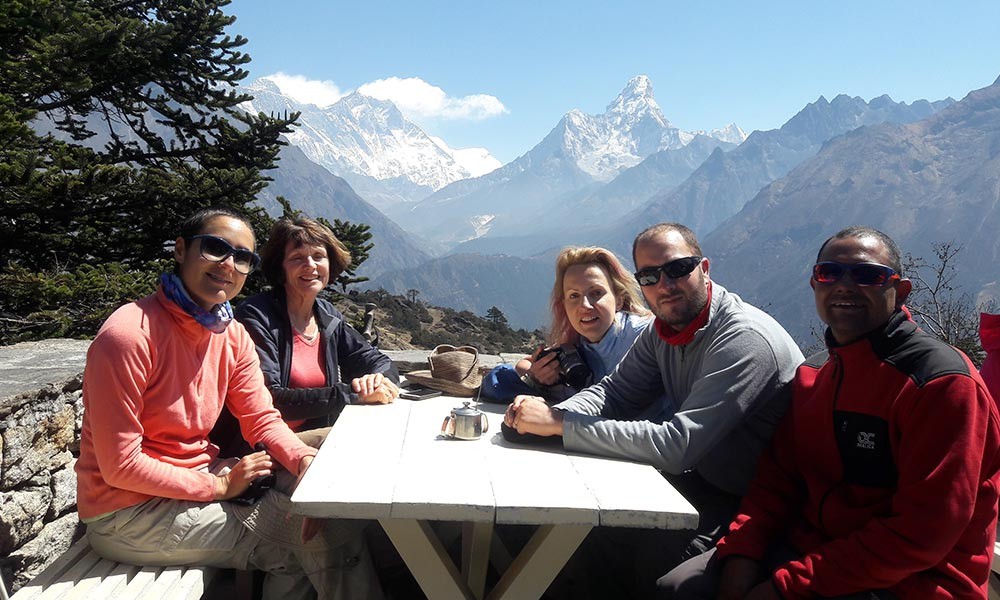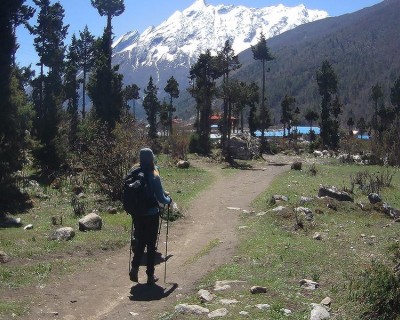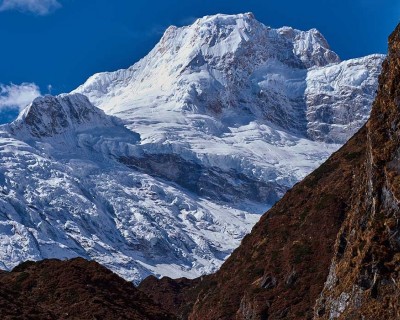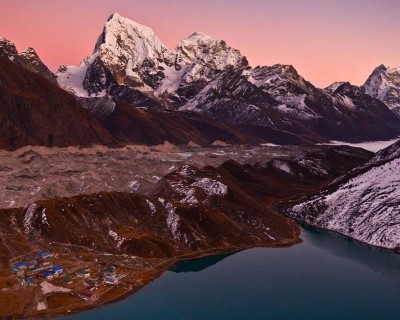In March, trails of Everest Base Camp will take you through the beautiful Sherpa villages. It’ll also let you enjoy the community's local traditions, culture, and warm hospitality. The expedition will also make sure that you encounter plenty of wild animals and birds during a walk through the Sagarmatha National Park.
Check our group joining EBC trek package.
Highlights of Everest Base Camp Trek
- Spectacular view of Mount Everest alongside Nuptse, Cho Oyu, and Ama Dablam
- Impressive and quiet subtropical forests
- Insight into the lifestyle in the Himalayas
- Discover unique flora and fauna
- Explore the ancient Tibetan monastery at Tengboche
- Clear and unobstructed view of Changtse from Kalapatthar
- Enjoying the local Nepali dishes
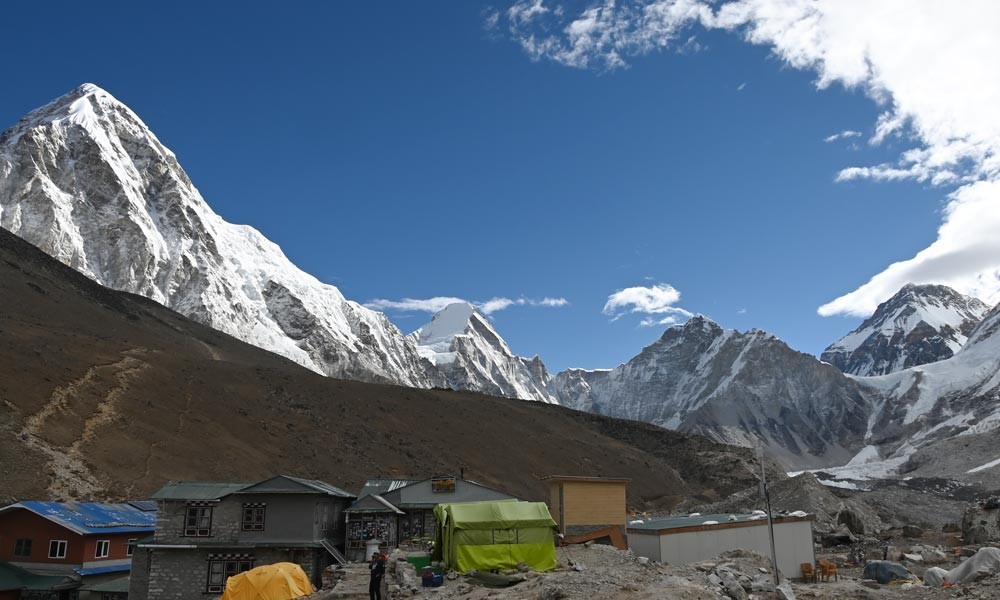
Outline Itinerary:
Day 01: Arrival at Kathmandu
Day 02: Sightseeing around Kathmandu Valley and trek preparation
Day 03: Fly to Lukla (2,860 m), then trek to Phakding (2,610 m), 3-4 hrs
Day 04: Trek from Phakding to Namche Bazaar (3,440 m), 6-7 hrs
Day 05: Rest day in Namche Bazaar
Day 06: Trek from Namche to Tengboche (3,860 m), 5-6 hrs
Day 07: Trek from Tengboche to Dingboche (4,360 m), 4-5 hrs
Day 08: Acclimatization at Dingboche
Day 09: Trek from Dingboche to Lobuche (4,930 m), 5-6 hrs
Day 10: Trek from Lobuche to Gorakshep (5,160 m) for 2-3 hrs, then hike to Everest Base Camp (5,364 m), 2-2.5 hrs
Day 11: Hike to Kala Patthar (5,644 m), 2 hrs, then trek down to Pheriche (3,210 m), 5 hrs
Day 12: Trek to Namche Bazaar, 7-8 hrs
Day 13: Trek to Lukla, 6-7 hrs
Day 14: Fly back to Kathmandu (1,400 m), 30 mins
If you have a shorter number of days for trekking, we can customize the package for you.
Check our 7 Days EBC trek Itinerary.
Why take Everest Base Camp Trek in March?
Given its breathtaking scenery and cool vibes, Everest Base Camp is great to travel all year round. But the best time to visit is during March when the weather has just begun to cool. The days start to warm up amid March with beautiful sunshine and increasing temperatures. March seems to outshine all other months with the spectacular view of lofty mountains, lush green forests, and hills. Here are some other reasons to trek Everest Base Camp in March.
1. Great Weather
The weather at Everest Base Camp is temperamental in March. It can be cold and hot, depending on the elevation. It’s mostly warm in the lower region from the start of the month, but it takes a bit more time to improve the weather at the mountain.
Khumbu Valley in March is bright and sunny, but the weather can get cold if the winter tightens its grip. Skies are clearer in the days, so it becomes easy for trekkers to watch the view of lush valleys, snow-capped mountains, and rugged cliffs.
2. Scenic trails
With the weather getting warmer and snow melting away, EBC trails are likely to impress trekkers in March. It appeals to them with majestic forests, green pastures, and terrace farms that look bleak in winter.
The walk on the trail is pleasant in March as it takes the hikers on an adventurous journey. The trek offers them a splendid view of gushing waterfalls, sweeping hills, and mountains. By the end of the month, visitors will witness new buds and wildflowers thriving in the national park.
3. Cultural Exploration
There's no doubt that Everest Base Camp has great scenery during March. But it also has various historical and cultural landscapes that trekkers can explore over time. The trails spread out within Khumbu Valley will lead you to one or the other Tibetan monasteries and chortens.
Mountainous terrains are fabulous and perfect for exploring beautiful Sherpa villages and landmarks. You can also visit the region's ancient monuments and religious heritage sites.
4. Fewer Crowds
The buzz of the spring crowd is missing at Everest Base Camp in March. With the weather still chilly at the mountain, trekkers wait for the peak spring month to hike. This allows the traveler to discover the best of Everest Base Camp without interruption.
Walking the trails in March is more fun as there is no fuss and a hullabaloo of crowds. Travelers won’t have to figure out how to get a good shot without getting people in the frame. Moreover, they can hike at their own pace and time on the course.
5. Accommodation
March can be lovely for the Everest Base Camp trek as there are few visitors around the time. Its trails are empty for the most part, and so are the accommodation, which leaves the hikers with many choices.
They can make a great deal and even get some discount on the standard price. Flights, lodging, and guesthouses are relatively cheaper in March, given the low number of travelers. Traveling around the region is cheap, but lodges will still be expensive in the town.
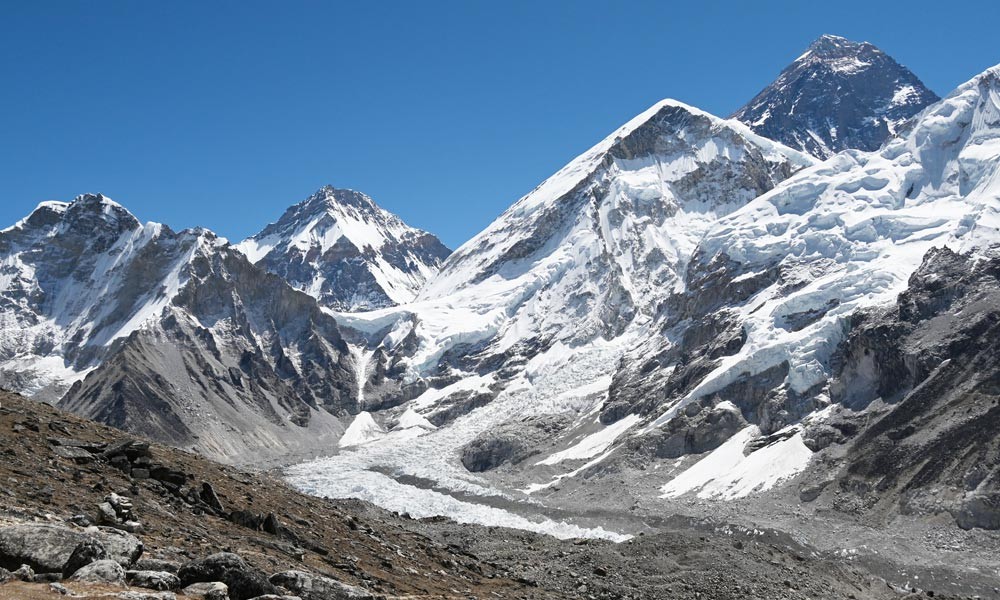
Difficulties of Everest Base Camp Trek in March
The hike to Everest Base Camp is not terribly difficult in March, but it has a few scruples, including distance. Trekkers have to deal with unpredictable weather changes, altitude gain, and several other difficulties during the hike. Here are some of them.
1. Length of Trail
Of course, the Everest Base Camp trek is a moderate hike with no technical difficulties. However, its 38.5 miles trail doesn’t agree so much with it. It makes every possible effort to create the journey difficult for hikers.
It takes them on a wild venture that involves scrambling steep hills, crossing multiple suspension bridges, and traveling the valley. They have to beat the rugged paths and walk through the dense forest with many switchbacks.
Trekkers have to walk approximately 5-6 hours each day and cover a distance of 10-15 km, which is terrifying. On top of that, they must navigate the harsh terrain that winds through tropical forests and highlands.
2. Altitude Sickness
Walking at any elevation above 3,500 meters can cause altitude sickness to hikers. It creates quite a challenge for hikers and sometimes even worsens their health. Since trekkers of Everest Base Camp have to travel up to 5,644 meters, they are more likely to feel headaches, dizziness, insomnia, and more.
These are all symptoms of altitude sickness due to low oxygen at the base camp. It may develop into serious conditions if they spend an extended time at high altitudes.
3. Physical fitness
Everest Base Camp Trek is physically demanding, with steep and lengthy trails. They walk up the hillsides and into the woods, which is intense. Trekkers can quickly lose their stamina and endurance while navigating the rugged trails, which have many ups and downs.
They easily get out of breath on these terrains, which is not good for their health. The trails at higher altitudes are even more brutal and unsympathetic. So, without proper preparation, the journey will be extremely tough for hikers
4. Trekking grade
Everest Base Camp is considered to have a moderate level of difficulty. There are plenty of obstacles on the course that are not so easy to defeat. Most of the sections above 3,000 meters are rough and well-worn.
The trail runs from under the rocks and boulders, which can be nerve-wracking for some voyagers. Although it has no technical sections, the ride is still long and hard. You have to trek along the edges of the river valley, meadow, and gorges to reach the base camp
5. Dehydration
It’s no secret that the trails of Everest Base Camp are pretty long and strenuous, so sipping away a bottle of water will never be enough. Everyday trekkers have to walk the steep trails in the spring heat of March.
Walking the trail at 15-20 degrees Celsius will make you lose a lot of sweat. It can even make you feel dizzy and worn out. So, don’t tire yourself and have more than sufficient water to prevent dehydration.
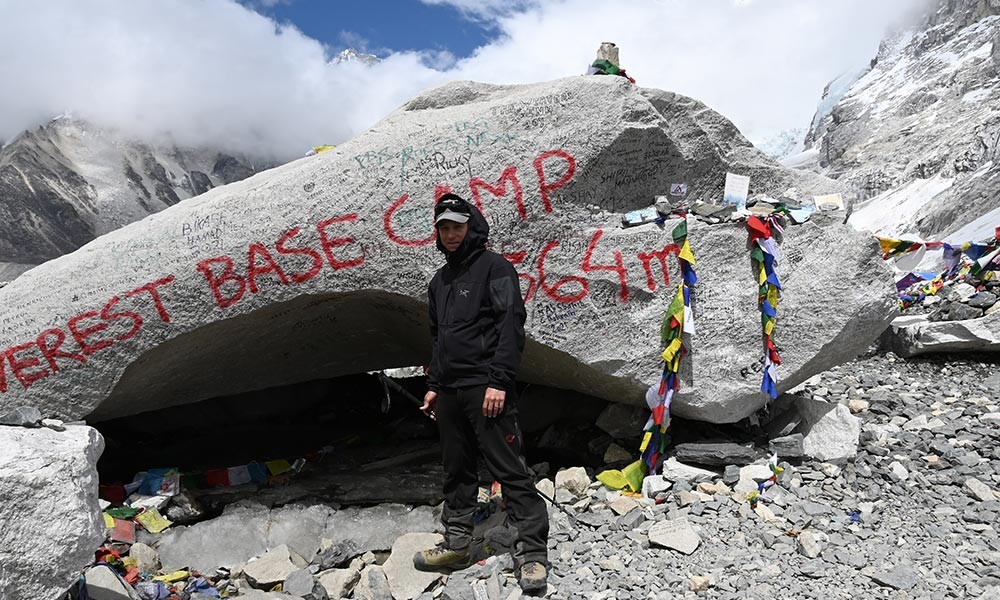
Weather and Temperature of Everest Base Camp in March
March generally tends to be warm at the base camp, with the temperature rising sharply. But it’s not sweltering hot or muggy, which is a plus for hikers who don’t like extreme heat. Since the temperature is rapidly changing, the weather might get a little warmer at the end of the month.
Unlike the previous month, it isn’t windy or stormy in March. The weather is much more stable and milder at this time, with beautiful sunny days. Evenings are usually chillier, so travelers must be prepared for it.
Since it’s early spring, the weather is cold at the beginning of the month. But after mid-March, the weather starts to get lovely. The average temperature during March is about 17 degrees Celsius in the daytime, but it drops significantly at night.
Evenings are generally colder with crisp air. The temperature during nights decreases to minus 0 Degree Celsius. Despite the effect of winter, the weather isn’t foggy during March, and the skies are almost clear. This makes it easy for trekkers to catch a glimpse of the surrounding mountains.
Food and Accommodation
Everest Base Camp Trek is mostly a teahouses trek. They are convenient and available anywhere you travel. Even the remotest area with no dense settlements has tea houses, making it more reliable. They are relatively cheaper compared to other lodgings.
Besides that, they come with basic facilities, which makes their stay in the region easier. Most of the teahouses have shared rooms, and this might be unpleasant for some hikers., But, cheer up as we can get you a single room with an en suite, but this will cost you a bit more than the normal price.
Facilities in the teahouse include a bed, pillow, blanket, towel, and other basic necessities. However, it’s better to bring a duffel bag on the trip as they are comfortable to travel with and have lots of space.
The teahouses along these courses will also provide you with delicious meals. They can serve you a wide variety of dishes and cuisines. But the most popular one is a traditional Nepalese meal consisting of rice, vegetables, pulses, pickles, lentils, and more.
The dish is healthy and nutritious to help you keep going on the trail. Besides that, you also have other foods to choose from, such as noodles, Thukpa, dumplings, and more. The typical breakfast in the Himalayas comprises tea, bread, cereals, soup, and spaghetti.
You may not find this food at all the locations. As you travel higher, the number of accommodations decreases, and so does the food. Getting the goods transported on the rugged trails of Khumbu is hard. Porters and yaks are the only means of transportation to carry the food items, thus, making them scarce and expensive.
Trekking routes of Everest Base Camp
The 62-km trail starts from Lukla and ends right at the base of Khumbu Icefall. Getting to the camp requires trekkers to pass several villages, ascend steep hills, and go up to the valley. They have to climb the trail off the mountainside and cross suspension bridges several times.
Trekkers have to walk through dense forest filled with pine and rhododendron in order to get to the top. The route to the base camp has a lot of steep and loose paths with switchbacks, which are not easy to navigate.
Trekkers have to work their way up through Namche, which is about 3,440 meters above sea level. The air is thin at this elevation, so the chance of altitude sickness remains high. Trekkers have to be careful while climbing up the hill to Tengboche.
As expected, the paths are rugged and steep from here. Hence, you must have good physical strength to defy the mountainous terrain. High plains, long steep hills, and loose rocks will await trekkers on the way to Dingboche.
After beating the trails, they have to walk 6.6 miles uphill to Lobuche, which is fairly strenuous. The height gain makes the trek physically demanding and more uncomfortable for hikers. The reward is well, though, as they get to view Everest from so close.
The final push to the base camp from Gorakshep is significantly difficult. Hikers can reach the camp only after climbing the rocky slopes and debris. They will also climb the rocky mountain known as Kalapatthar to capture the perfect shot of Everest.
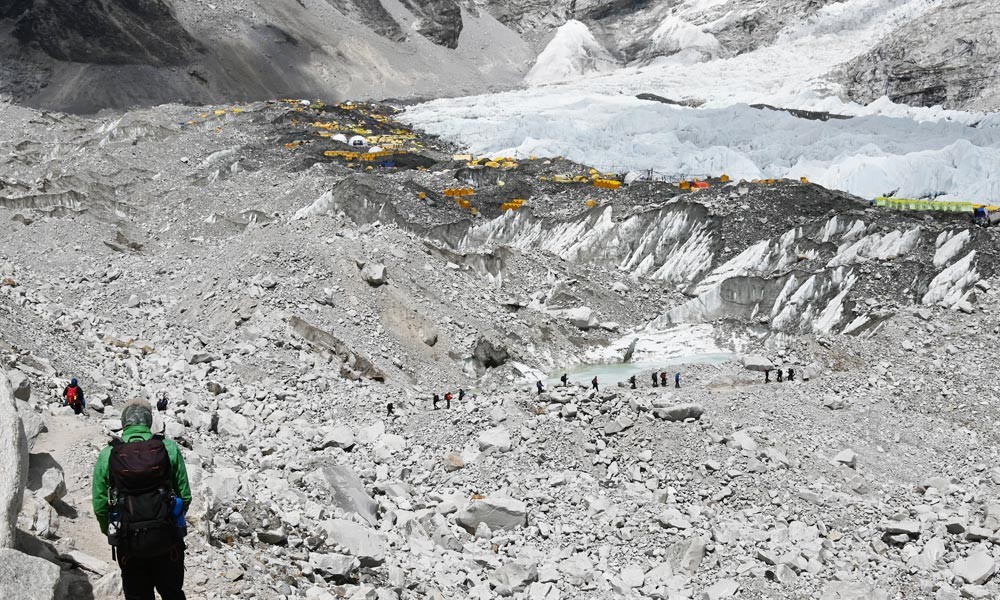
Preparation of Everest Base Camp Trek
Trekking Everest Base Camp in March doesn’t require incredible preparation. There’s no need to spend months and months on training. You can just focus on a few exercises that help to improve your stamina and keep you determined.
Lack of physical fitness can create challenges for hikers. So, you have to be fit and healthy in order to ascend the steep trail of Everest Base Camp. Training your leg and muscles is very important as it keeps you going on the trail.
Focus on long-term fitness, and don’t get injured. Choose cardiovascular exercises like running, brisk walking, and swimming to help you stay fit. Go on a frequent long-distance walk before the hike. This will help you perform well on the actual day of the trek.
Along with physical preparation, you also have to take care of your mental health. No trekkers should stress or overwork themselves as this can adversely impact their health. You have to be mentally tough on and off the trail, or else it’ll be too difficult for you to survive on the journey.
Essential Equipment
March is a mix of Spring and Winter seasons, so you’ll have to be too careful of what you pick. The equipment you pack must be convenient and applicable during the hike. They must come into use while scrambling the iconic trails of Khumbu, crossing rivers, and traveling beside the frozen lakebed.
If you plan on traveling to the base camp in early March, bring warm clothes, as the weather is still chilly. However, if the trek is to happen after mid of March, carry more lightweight clothes.
Clothing
- Down or insulated jacket
- Short and long-sleeved shirt
- Waterproof trousers or pants
- Trekking pants
- Fleece sweater
- Full-body thermal
Handwear
Shoes & Footwear
- Trekking shoes
- Hiking boots
- Synthetic or woolen socks
Other items
- Extra batteries, charger, powerbank
- Personal toiletries
- Quick-drying towel
- First-aid kit
- Moisturiser
For those seeking an additional level of challenge and excitement in their Himalayan adventure, the Everest Three High Passes Trek is a fantastic choice. This trek not only encompasses the traditional Everest Base Camp route but also traverses three of the highest passes in the Everest region, providing stunning vistas and a unique experience of the region's varied landscapes.
FAQs
1. Where is Everest Base Camp?
Everest Base Camp is nested on the top of a rock-covered glacier in Khumbu Valley. It lies in northeastern Nepal and is part of the Solkuhumbu District.
2. What are the permits required for Everest Base Camp Trek?
Since Everest Base Camp is a protected area, trekkers have to receive trekking permits to travel in the region. Sagarmatha National Park permit and Khumbu Pasang Lhamu Rural Municipality entrance permits are required for this trek. However, if you’re traveling with us, the permit will be arranged in advance.
3. Is Everest Base Camp Trek fit for beginners?
Everest Base Camp has a moderate hiking trail, so it’s fair to say that the trek is perfect for beginners. However, you do have to make the necessary preparations and pack ahead of the trek. Hiring a guide is also essential for Everest Base Camp Trek as the trails are new to beginners.
4. What’s the food like at Everest Base Camp?
On the trip, we’ll dine in a local teahouse and delight in experiencing authentic Nepali cuisine. You’ll even have the chance to eat in a five-star hotel during our stay in Kathmandu. They feature a wide variety of delicious food. On the high-altitude base camp trek, we’ll be accommodated with different local dishes made of fresh and farm products.
5. Is Altitude Sickness a major threat for trekkers of Everest Base Camp?
Altitude Sickness can be a challenge for trekkers at Everest Base Camp. The oxygen level and air pressure are pretty low in the higher altitude region. Therefore, you should acclimatize well to prevent altitude sickness. Avoid traveling too high and fast, as it’s hard to catch your breath.
6. Is travel insurance required for the trek?
Everest Base Camp Trek is a multi-day hike with lots of obstacle courses. Most of its trails are jagged and steep, causing health risks. Altitude sickness and weather change are some other serious challenges for hikers. These can cause them huge financial losses on medical. So, to avoid such risks, trekkers are recommended to get travel insurance for this hike.
7. Who are guides, and why are they important?
Guides are the local experts who can help you navigate the way. They play a significant role in making your journey safe and easier. Guides will help you to communicate with locals and know their cultures. Importantly, they will identify and let you know about the mountains you see while trekking.
8. Is it possible to go solo on Everest Base Camp Trek?
Everest Base Camp is a remote area trek with rough and undiscovered terrains. It’s easy to get lost on these wide extended weaving trails. Traveling in restricted areas is even more difficult as not many travelers walk the course. Therefore, it’s irrelevant and unsafe to trek Everest Base without a professional guide.
9. What accommodations are available during Everest Base Camp Trek in March?
March isn’t the peak spring month, so the trails are less crowded. You can easily find rooms in any accommodation of your choice. There‘s no need to book a room in advance, but doing so will help you get the rooms at a lower price. Teahouses are more popular at higher altitudes as they are comfortable to live in and have all the amenities required during the hike.
You might also like to read: EBC Trek in September, Everest Base Camp Trek in October
